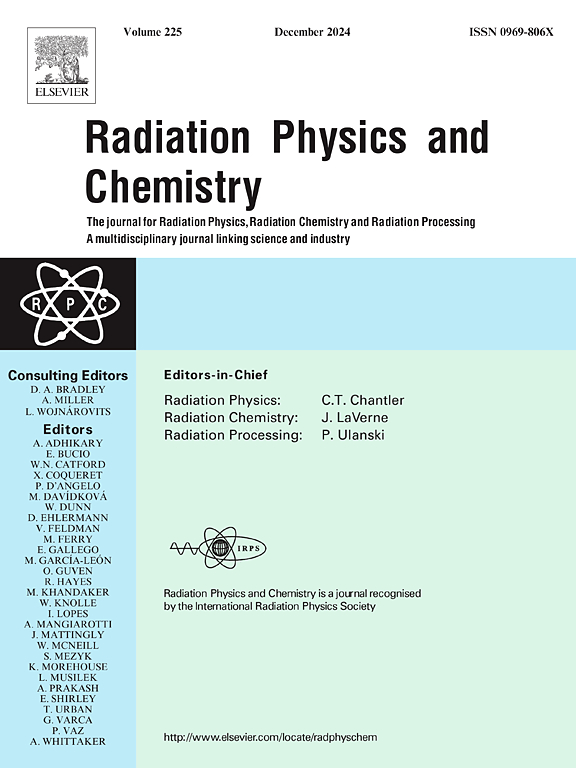非共面剂量重建评价立体定向治疗前质量保证的分析
IF 2.8
3区 物理与天体物理
Q3 CHEMISTRY, PHYSICAL
引用次数: 0
摘要
现代立体定向放射外科(SRS)或立体定向放疗(SRT)治疗通常结合共面和非共面光束来增强剂量一致性。然而,针对非共面装置的患者特异性质量保证(PSQA)仍然具有挑战性。在幻影的数据采集过程中,与非共面波束相关的couch角经常坍塌到0°,无论其预期的空间配置如何。这种简化防止了假体的偏转,但不能准确地复制治疗中使用的实际非共面几何形状。本研究旨在评估在剂量重建中纳入非共面几何与假设共面几何重建的影响,并量化在PSQA结果中观察到的差异。本文章由计算机程序翻译,如有差异,请以英文原文为准。
Analysis of non-coplanar dose reconstruction for evaluating pre-treatment quality assurance in stereotactic treatments
Purpose
Modern stereotactic radiosurgery (SRS) or stereotactic radiotherapy (SRT) treatments often combine coplanar and non-coplanar beams to enhance dose conformity. However, patient-specific quality assurance (PSQA) for non-coplanar setups remains challenging. During data acquisition in the phantom, couch angles associated with non-coplanar beams frequently collapse to 0°, irrespective of their intended spatial configuration. This simplification prevents deflection of the phantom but does not accurately replicate the actual non-coplanar geometry used in treatment. This study aims to evaluate the impact of incorporating non-coplanar geometry in dose reconstruction compared to reconstructions assuming coplanar geometry and to quantify the differences observed in PSQA outcomes.
Material and methods
The Octavius 4D system, integrated with a 1000 SRS detector array, acquired pre-treatment measurement data for ten SRS/SRT treatment verification plans under planar and non-coplanar beam configurations. Measurement data were analyzed using the Octavius system in conjunction with Verisoft software and compared against treatment planning system-generated verification plans. Dose comparison and validation were conducted using gamma evaluation with criteria of 1 mm/2 %, 2 mm/2 %, and 3 mm/3 % applied across axial, coronal, and sagittal planes in two-dimensional (2D) and three-dimensional (3D) volumetric assessments.
Results
Non-coplanar reconstructions showed significantly higher gamma passing rates in coronal and sagittal planes under stringent criteria, with no significant differences in the transverse plane. Global gamma ratios revealed greater variability in the coronal plane, with 3D analyses less consistent than 2D. Correlations between 2D and 3D evaluations weakened as gamma criteria relaxed.
Conclusions
Non-coplanar dose reconstruction demonstrated superior accuracy in 3D verification by preserving the integrity of couch angles, eliminating the need for their collapse during analysis. The findings recommend adopting a 2 %/2 mm gamma evaluation criterion for both planar and non-coplanar measurements, while a more stringent 1 mm/2 % criterion is suggested for pre-treatment verification of non-coplanar setups to ensure higher precision.
求助全文
通过发布文献求助,成功后即可免费获取论文全文。
去求助
来源期刊

Radiation Physics and Chemistry
化学-核科学技术
CiteScore
5.60
自引率
17.20%
发文量
574
审稿时长
12 weeks
期刊介绍:
Radiation Physics and Chemistry is a multidisciplinary journal that provides a medium for publication of substantial and original papers, reviews, and short communications which focus on research and developments involving ionizing radiation in radiation physics, radiation chemistry and radiation processing.
The journal aims to publish papers with significance to an international audience, containing substantial novelty and scientific impact. The Editors reserve the rights to reject, with or without external review, papers that do not meet these criteria. This could include papers that are very similar to previous publications, only with changed target substrates, employed materials, analyzed sites and experimental methods, report results without presenting new insights and/or hypothesis testing, or do not focus on the radiation effects.
 求助内容:
求助内容: 应助结果提醒方式:
应助结果提醒方式:


